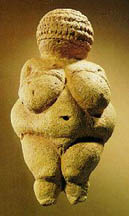Art of Prehistory
Paleolithic
Period
(30,000-10,000 B.C.E.)
The most
famous cave paintings are those found within the Lascaux caves of France. Painted with earth pigments
of red and yellow ochre and charcoal mixed with animal fat, they are extraordinary
examples of the artistic capabilities of prehistoric men. The images combine
their creator's understanding of the animal forms, an elegant sense of line,
and vigorous gesture. It is a widely held belief among anthropologists that
these paintings had a magical purpose for the tribal societies that created
them. Painted deep within the caves, these caverns were sacred spaces. It
is very possible that, within this earthly womb, the tribes performed magic
rituals related to the hunt.
Carbon dating reveals that the
Lascaux cave paintings were created sometime between 15,000 - 10,000 B.C.E
(before the common era). For many years, scientists believed that these
were some of the first artworks created by humankind. In 1994, however,
paintings were discovered in another cave in France known as the Chauvet
cave. These paintings date back to around 30,000 B.C.E, pushing back the
history of art by several thousand years. It could be possible that some
artworks were created even earlier than this. Anything that may have been
created with less permanent materials are lost. The only way we can know
anything about the earliest humans comes from study of their paintings,
carvings, and tools. The carving at right looks like a lion's head combined
with a human body. We can only guess what significance this may have had.
Perhaps early man recognized that other animals were more powerful than
they were, and wished to possess that power themselves.

Venus of Willendorf |

Venus of Laussel |
Prehistoric carvings which have
inspired much speculation are those of women, known as "venus"
figures. Above are two of the most famous examples, though hundreds of similar
figures have been discovered throughout Europe.. The term actually has nothing
to do with the goddess of love, but is used to identify these feminine figurines-
which all exaggerate the reproductive features of large breasts, hips, and
abdomen. It is unclear exactly what their significance was for early peoples.
Very few,if any, figures were found in the shape of men, so we know that
the choice of gender is significant. We can only guess that they may have
served as a charm for bringing fertility. Most of them are very small (only
several inches in height), and were possibly carried. The Laussel Venus
is an exception, carved on a cliff site. The horn which she holds in her
right hand suggests the idea of the "horn of plenty"... perhaps
suggesting the bountiful reproduction not only of their own species, but
of all things necessary for survival.
|
Many of the best artifacts
of early humans exist in western Europe. The Lascaux, Chauvet, and
many other cave paintings exist in southern and central France. Another
well-known cave is the Altamira in northern Spain.
The Venus of Willendorf
was found in Austria, and the Laussel Venus is close to the caves
of Lascaux.
Stonehenge is located on
the Salisbury Plain, in England. Many other similar structures have
been found in that continent. |
Neolithic
Period
(10,000-4000 B.C.E)
The art
of the paleolithic period is very naturalistic, especially when compared
to the artwork created by Neolithic peoples. With the progress of the Agricultural Revolution, it was no longer necessary
for tribes to follow the animals, but instead to breed herds and cultivate
crops. The focus of their
arts thus shifted from the magical purpose of bringing luck in the hunt
to the domestic purpose of storing liquids and grains. Most of the art
of this period serves a functional purpose, but the designs on their vessels
show that they had a great concern for beauty as well as functionality.
Decorations are generally geometric and abstract, with an interest in
repeated patterns.
Stonehenge, circa 2000-1500 B.C.E. Salisbury Plains, England ... Height of
stones approximately 13'6"
The megalithic site commonly
known as Stonehenge is one of the most fascinating structures known
to mankind. It has been the object of much serious study as well as
wild speculation. Before the invention of the wheel, primitive people
were somehow able to drag the huge stones over land and water. The first
stone placed at the site was the heel stone, which is outside of the
circular ditch circumscribing the monument. 200 years later, 80 blocks
of bluestone were transported from a quarry nearly 200 miles away. Some of these stones weigh
as much as 26 tons. The horizontal lintel stones were secured on top
of the vertical posts with ball and socket joints. The last stone added
was the altar stone, which was transported from South Wales.
It has long been theorized
that Stonehenge was used as a giant calendar to study the heavens. In
1964, evidence of this was provided by an astronomer named Gerald Hawkins.
Using a computer, he calculated the positions of the stars and planets
during the Neolithic age, finding that the placement of key stones lined
up precisely with solstices and equinoxes. He also proposed that the
site was used to predict eclipses and other cosmic phenomena. Whether
this was its true purpose is still a subject of debate. It is clear
that the monument served a purpose of some importance for these stone
age people to divest so much of their energy into it. Most likely, they
were a nature-worshipping society, and their altar stone probably served
the purpose of animal sacrifices.
Next: Mesopotamian
Art
|